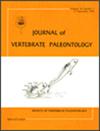Pliocene pre-GABI herbivorous mammals from Espinar, Peruvian Andean Plateau
IF 1.9
4区 地球科学
Q2 PALEONTOLOGY
引用次数: 0
Abstract
ABSTRACT Pliocene South American mammals prior to the Great American Biotic Interchange comprise the evolutionary pinnacle of a long-lasting process of continental isolation, in which large-scale orogeny and climate change were instrumental. These processes resulted in unique assemblages of extinct groups with peculiar anatomies. However, interpretation of the functional roles that these organisms would have played in the ecosystem is challenging because well-preserved fossils of this time interval in South America are scarce. Here, we describe a new Early Pliocene assemblage of native herbivorous megamammals documented by skeletons in anatomical connection from the Peruvian Andean plateau (city of Yauri in Espinar, Cusco Department). Fossil-bearing deposits pertain to Member C of the El Descanso Formation dated at 4.75 ± 0.5 Ma, when the plateau attained near-modern elevations and a Puna-type plant ecosystem. The mammal assemblage is dominated by xenarthrans, including three ground sloths (cf. Megatheriops rectidens, Simomylodon uccasamamensis, and Proscelidodon sp.) and Andinoglyptodon mollohuancai gen. et sp. nov., the first Pliocene glyptodontine known by a well-preserved cranium and dermal armor. Notoungulates are represented by the toxodontid Posnanskytherium viscachanense. Both selective and bulk feeders are identified, suggesting the existence of diverse plant resources in the Pliocene Puna ecosystem. These native mammals constituted the typical Pliocene herbivorous guild of the central Andean plateau and provide an opportunity to investigate the structure of mammalian communities just before the arrival of Holarctic immigrants. RESUMEN Los mamíferos sudamericanos del Plioceno previos al Gran Intercambio Biótico Americano constituyen el pináculo evolutivo de un proceso prolongado de aislamiento continental, en el que la orogenia a gran escala y el cambio climático fueron fundamentales. Estos procesos resultaron en ensambles únicos de grupos extintos con anatomías inusuales. Sin embargo, la interpretación de los roles funcionales que estos organismos habrían jugado en el ecosistema es un reto porque fósiles bien preservados de este intervalo temporal en Sudamérica son escasos. Aquí, describimos un nuevo ensamble de megamamíferos herbívoros nativos del Plioceno temprano documentado por esqueletos en conexión anatómica del altiplano Andino peruano (ciudad de Yauri en Espinar, departamento de Cusco). Los depósitos con fósiles pertenecen al Miembro C de la Formación El Descanso datados en 4.75 ± 0.5 Ma, cuando el altiplano alcanzó elevaciones casi iguales a las modernas y un ecosistema de plantas de tipo Puna. El ensamble de mamíferos está dominado por xenartros, incluídos tres perezosos terrestres (cf. Megatheriops rectidens, Simomylodon uccasamamensis y Proscelidodon sp.) y Andinoglyptodon mollohuancai gen. et sp. nov., el primer gliptodonte del Plioceno conocido por elementos craneales y la armadura dérmica bien conservados. Los notungulados están representados por el toxodóntido Posnanskytherium viscachanense. Se identificaron tanto alimentadores selectivos como masivos, lo que sugiere la existencia de diversos recursos vegetales en el ecosistema de la Puna del Plioceno. Estos mamíferos nativos constituyeron el gremio de herbívoros típico del Plioceno del altiplano andino central y proveen una oportunidad para investigar la estructura de las comunidades de mamíferos justo antes de la llegada de los inmigrantes holárticos.来自秘鲁安第斯高原埃斯皮纳尔的上新世前GABI草食性哺乳动物
本文章由计算机程序翻译,如有差异,请以英文原文为准。
求助全文
约1分钟内获得全文
求助全文
来源期刊
CiteScore
2.90
自引率
7.10%
发文量
58
审稿时长
4-8 weeks
期刊介绍:
The Journal of Vertebrate Paleontology publishes original contributions on all aspects of vertebrate paleobiology, including vertebrate origins, evolution, functional morphology, taxonomy, biostratigraphy, phylogenetics, paleoecology, paleobiogeography, and paleoanthropology. JVP publishes high quality peer-reviewed original articles, occasional reviews, and interdisciplinary papers. It is international in scope, and emphasizes both specimen- and field-based based research and the use of high-quality illustrations. Priority is given to articles dealing with topics of broad interest to the entire vertebrate paleontology community and to high-impact specialist studies. Articles dealing with narrower topics, including notes on taxonomic name changes (unless these deal with errors published in JVP), preliminary site reports, and documentation of new specimens of well-known taxa, are afforded lower priority.

 求助内容:
求助内容: 应助结果提醒方式:
应助结果提醒方式:


